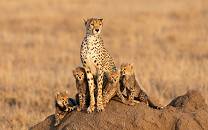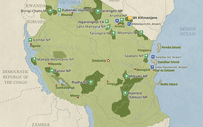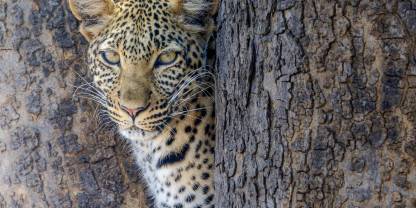Tanzania, with its three safari circuits, is one of Africa’s top wildlife destinations. The popular Northern circuit incorporates bucket-list landmarks such as Serengeti National Park, Ngorongoro Crater and Mt Kilimanjaro. Repeat visitors might prefer the remote wilderness vibe of the Southern or Western circuits. For some beach time, the ‘Spice Island’ of Zanzibar is only a short flight away.

-
Rates (USD)
- $220 to $628 pp/day
-
Best Time To Go
- June to October; January to February (For wildebeest calving)
-
High Season
- July to March (North), June to October (South and west)
-
Size
- 947,303km² / 365,756mi²


Pros & Cons
- Superb wildlife viewing, including the annual in Serengeti
- Off-the-beaten-track safaris in Katavi and Ruaha National Parks
- Several wildlife-viewing circuits for repeat visits
- Best in Africa in Gombe and Mahale Mountains National Parks
- Beach holiday extensions on Zanzibar
- Traditional cultures
- Relatively expensive safari destination
- Some popular parks can be crowded
Wildlife
You’ll see an abundance of animals when on safari in Tanzania. Elephant, giraffe, buffalo, warthog and hippo are prolific throughout, and in Serengeti you might see several million wildebeest, gazelle and zebra on their annual migration. Predators are common too, especially lion and spotted hyena. You’ll need to go to Ruaha or Nyerere (Selous) National Parks to see the endangered wild dogs. Black rhino is easy to spot in the Ngorongoro Crater, but for an intimate encounter with these safari heavyweights, Mkomazi National Park is hard to beat.
More about the wildlife
Things To Do
Tanzania is a stellar safari destination. are possible in most national parks; some also offer . Boat safaris are available in Nyerere NP, and you can track chimps in Mahale Mountains or Gombe. For hikers, the multiday ascent of Kilimanjaro stands out, but other possibilities include Mt Meru and the Usambara Mountains. Swimming, snorkeling, diving and water sports can be enjoyed on a stunning Indian Ocean coastline that includes Zanzibar.
Weather & Climate
The Dry season (June to October) sees the daytime temperature vary between 20°C/68°F and 30°C/86°F. It’s useful to remember that the higher the altitude, the cooler it will be. The Wet season (November to May) kicks off with the short rains (November to December), followed by a drier interlude and then the long rains (March to May).
More about the weather and climate
Best Time To Visit
Wildlife viewing is generally best in the Dry season (June to October). This is also the best time to see the in Western and Northern Serengeti. January to February is the time when the wildebeest are in Southern Serengeti to have their calves. While some Southern and Western circuit parks are off-limits in the Wet season (November to May), the Northern circuit parks still have productive during this time.
More about the best time to visit
Premier Parks & Reserves
- Serengeti NP – Classic safaris
- Ngorongoro Crater – Classic safaris
- Lake Manyara NP – Classic, walking and canoe safaris
- Tarangire NP – Classic and walking safaris
- Nyerere NP – Classic, boat and walking safaris
- Ruaha NP – Classic and walking safaris
- All 15 Tanzania Parks & Reserves




